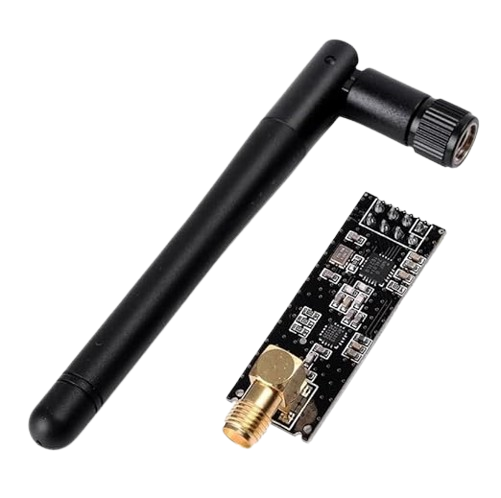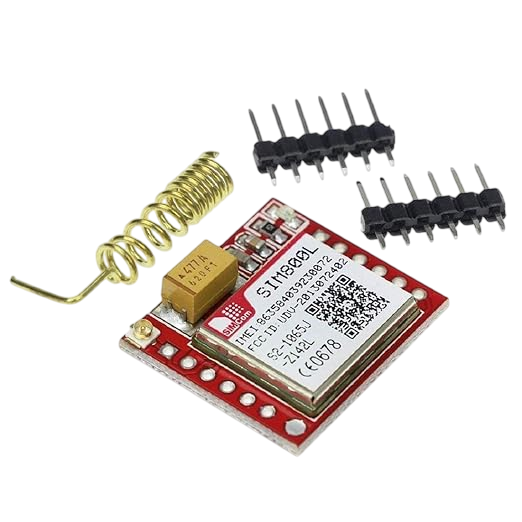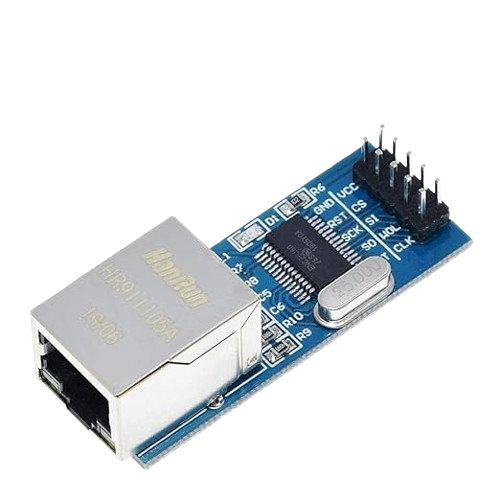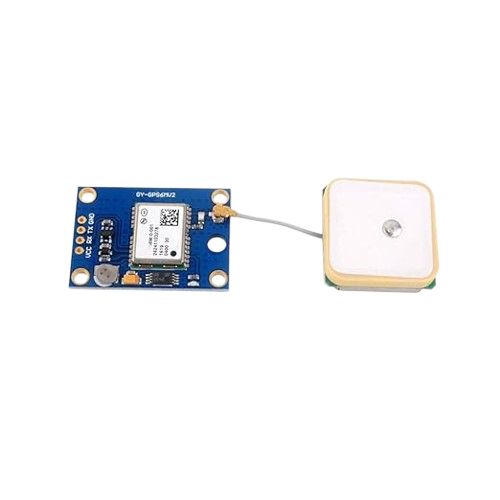nRF24L01 RF Module: Complete Guide to Pinout, Working, Specifications, and Arduino Code Examples

Overview
Introduction to nRF24L01
The nRF24L01 is a popular 2.4GHz RF transceiver module developed by Nordic Semiconductor. It is widely used for implementing short-range, low-power wireless communication between microcontrollers using the SPI (Serial Peripheral Interface) protocol.
It operates on the globally license-free 2.4GHz ISM band, offering data rates of up to 2 Mbps and supporting multiple devices in a star or mesh topology.
This guide provides detailed technical information about the module’s pinout, specifications, working principle, module types, and an implementation example using Arduino.Key Features and Technical Specifications
| Parameter | Value |
|---|---|
| Frequency Range | 2.400 – 2.525 GHz (ISM Band) |
| Modulation | GFSK |
| Data Rate Options | 250 Kbps, 1 Mbps, 2 Mbps |
| Operating Voltage | 1.9V – 3.6V (typically 3.3V) |
| Current Consumption | TX: ~11.3 mA @ 0 dBm, RX: ~13.5 mA |
| Communication Interface | SPI (up to 10 Mbps) |
| Maximum Range | ~100 meters (with PA+LNA module) |
| Antenna Type | PCB Trace or External Antenna |
| Number of Channels | 125 |
| Max Payload Size | 32 Bytes |
| Operating Temperature | -40°C to +85°C |
Pinout Description (8 Pins)
| Pin | Name | Description |
|---|---|---|
| 1 | GND | Ground |
| 2 | VCC | Power Supply (3.3V only, Do not use 5V) |
| 3 | CE | Chip Enable: Enables data transmission/reception |
| 4 | CSN | Chip Select Not: SPI enable pin |
| 5 | SCK | SPI Clock Input |
| 6 | MOSI | SPI Master Out Slave In |
| 7 | MISO | SPI Master In Slave Out |
| 8 | IRQ | Interrupt Request Output (optional) |
Note: The nRF24L01 module is not 5V tolerant. Always use a 3.3V regulator or a logic level converter when interfacing with 5V microcontrollers like Arduino Uno.
Working Principle
The nRF24L01 operates in half-duplex mode, meaning it can either transmit or receive data at any one time, but not both simultaneously. It uses the GFSK (Gaussian Frequency Shift Keying) modulation technique to transmit digital signals wirelessly.
Communication is achieved via SPI protocol with an external microcontroller that controls all settings, such as:- Setting communication address
- Selecting channel frequency
- Enabling acknowledgment
- Handling received/transmitted data
The module supports auto acknowledgment (ACK) and auto retransmit, improving data reliability.
Types of nRF24L01 Modules
There are mainly two variants available:1. nRF24L01 (Basic Version)
- PCB trace antenna
- Limited range (~50–100 meters LOS)
- Compact and suitable for indoor applications
2. nRF24L01+PA+LNA (Power Amplifier + Low Noise Amplifier)
- External SMA antenna
- Extended range (~1000 meters in open space)
- Higher power consumption
- Best for long-distance and outdoor usage
Applications (General - Non-IoT Specific)
- Wireless keyboard/mouse
- Wireless data logger systems
- Remote controls
- Sensor networks
- Robotics communication
- PC to PC wireless data link
- Industrial automation communication
Example: Interfacing nRF24L01 with Arduino (Transmitter & Receiver)
Hardware Required:
- 2 × Arduino Uno/Nano
- 2 × nRF24L01 modules
- 10 µF capacitor (recommended for stability)
- Jumper wires
- 3.3V Regulator (for stable power)
Wiring – Arduino to nRF24L01
| nRF24L01 Pin | Arduino Uno Pin |
|---|---|
| VCC | 3.3V |
| GND | GND |
| CE | D9 |
| CSN | D10 |
| SCK | D13 |
| MOSI | D11 |
| MISO | D12 |
| IRQ | Not Connected |
Arduino Code – Transmitter
Arduino Code – Receiver
Troubleshooting Tips
| Problem | Solution |
|---|---|
| Module not working | Ensure 3.3V stable power supply with capacitor |
| Data not received | Check wiring and SPI pins |
| Low range | Use PA+LNA version or SMA antenna |
| Garbage values received | Check baud rate and matching addresses |
| Arduino resets/reboots | Use 10µF capacitor across VCC-GND |
Where to Buy
Prices may vary. Click on "Buy Now" to check current availability and pricing.
Administrator
Frequently Asked Questions
Common questions about nRF24L01 RF Module: Complete Guide to Pinout, Working, Specifications, and Arduino Code Examples. Find answers to the most frequently asked questions.
User Reviews & Comments
Share your experience with this IoT Blog. Your feedback helps our community make informed decisions!
Share Your Experience
Help others by sharing your thoughts about this IoT Blog.
Related Blogs
Explore more IoT Blogs in the same category

SIM800L GSM Module: Complete Guide for IoT Communication, Features, Circuit, and Interfacing (2025)
Communication Modules
Discover everything about the SIM800L GSM Module in this complete guide. Learn its features, working, circuit design, and how to interface it with Arduino or ESP32. Ideal for IoT communication projects, this tutorial covers all essential details with expert-level insights for developers and engineers.

ENC28J60 Ethernet Module: Complete Guide, Specifications, Features, and Applications
Communication Modules
The ENC28J60 Ethernet Module is a reliable, low-cost solution for adding wired network connectivity to microcontroller-based projects. This detailed guide covers its specifications, features, benefits, pin configuration, working principle, and common applications. Learn how the ENC28J60 enables seamless Ethernet communication with efficient data transfer for various embedded systems and networking projects.

Neo-6M GPS Module: Features, Specifications, Working, and Applications Explained
Communication Modules
The Neo-6M GPS Module is a high-precision, cost-effective positioning device widely used for navigation, tracking, and location-based applications. This guide covers its key features, technical specifications, working principle, and practical uses. Learn how the Neo-6M GPS delivers accurate data, supports multiple satellite systems, and ensures reliable performance for a wide range of projects and industries.
No Reviews Yet
Be the first to share your experience with this IoT Blog!